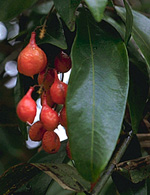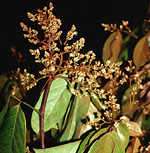 |
A small, pantropical family, two species of Connaraceae are found in Australia, both in the rain forests of north-east Queensland.
Characteristic features of the family Connaraceae in Australia include: - twining shrubs or scramblers with alternate, trifoliolate or pinnate, stiff, leathery leaves
- flowers small, regular, borne in terminal or axillary panicles
- petals and sepals 5, stamens 10, ovary of 1-5 free carpels
- fruits are dry follicles each with 1 or 2 arillate seeds
Description
Evergreen woody or herbaceous vines, climbing by twining or scrambling stems. Internal secretions not obvious, or of mucilage. Plants glabrous. Leaves alternate and spiral, petiolate. Stipules and stipellae absent. Lamina once compound, imparipinnate, symmetric; leaflets elliptic or oblong; base cuneate or attenuate; margins entire, ±flat; venation pinnate, with the midrib conspicuous, and the tertiary venation reticulate or not; surfaces not punctate; leathery. All the flowers bisexual. Inflorescences terminal or axillary, consisting of racemes or panicles. Bracts and bracteoles present. Pollination by insects. Flowers stalked. Floral disc present or absent; nectaries present on the disc or the carpels. Perianth regular, of 2 dissimilar whorls. Calyx segments fused, with 5 lobes, imbricate or valvate in bud; calyx bell-shaped, herbaceous. Corolla segments free or fused, with 5 petals or lobes, alternating with the calyx lobes, imbricate in bud; corolla bell-shaped, cream, without contrasting markings, membranous; claws absent; lobes ±entire. Fertile stamens 10, both alternating with and opposite to the calyx lobes, free of the corolla, free of the ovary and style, fused by their filaments into an open or closed tube, all ±equal. Anthers dorsifixed, versatile, opening inwards by longitudinal slits; 2-celled. Ovary superior and sessile. Carpels 1 or 4–5, free or incompletely closed. Style terminal, single and unbranched. Ovules 2 per locule; placentation basal or marginal. Fruit a dry, dehiscent follicle; the perianth on the maturing fruit deciduous or dry and persistent. Disseminule micro-surface ±smooth, brown or black, glossy or dull. Seeds 1–2 per fruit. Aril present. Cotyledons 2.
(Note: this description has been generated from the coded data compiled for the key. Any errors in the key data will be reflected in the descriptions.)
A treatment of the family Connaraceae has not yet been published in the
Flora of Australia. It will appear in Volume 10.
Australian genera of Connaraceae (as recognised for the Flora of Australia)
Connarus
Rourea

|
  |

Connarus conchocarpus (fruits)
Photo: J.Wrigley © ANBG

Connarus conchocarpus (flowers)
Photo: G.Sankowski © Zodiac Publications
|
 |
|